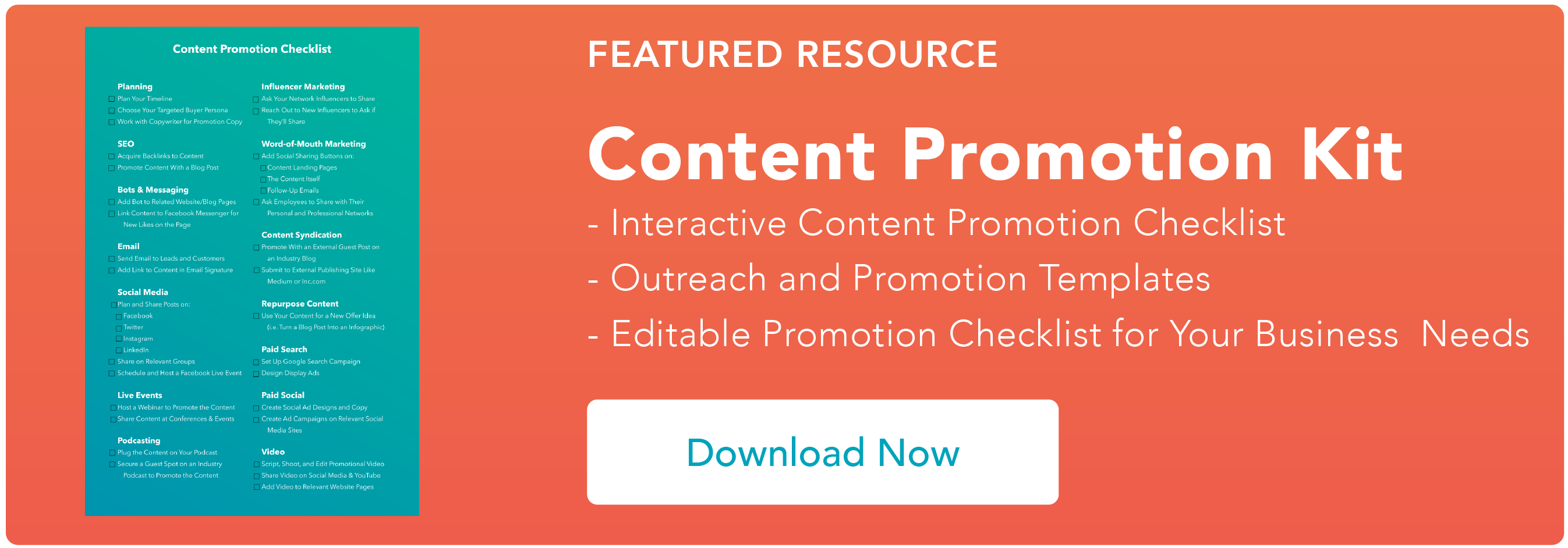We’ve all been there — you hit publish on a blog post and expect the social shares, page views, and agreeable comments to start rolling in. But sometimes you get pure silence (or crickets 🦗) in response.
Using social media and content to market your business isn't a new concept, so doing the bare minimum won't cut it.
Don't believe me? Think about how often content is shared across the web — for instance, there are over 2.45 billion Facebook users and over 500 million Tweets shared per day on Twitter — and that's only two of the several popular social platforms. Needless to say, there's a lot of content everywhere ... and as a result, a ton of noise.
Download Now: Content Promotion Templates + Kit
It takes more than simply publishing content to stand out among your target audience and competitors. To prepare you for success from the get-go, here are six ways to cut through all of that noise and make sure your content comes out on top every time — no additional marketing effort required.

6 Ways to Create Content That Markets Itself
Follow these tips to ensure your business's content stands out, spreads naturally, and markets itself among your target audience, buyer personas, leads, and customers.
1) Don't try something new.
Wait. What?
Seriously. There's no reason you'd need to start from scratch with a completely new content approach every time you create blog.
You already have content that's getting discovered on its own — so, learn from those efforts. (Remember, sometimes you can simply work smarter rather than harder.)
Review your analytics and look for the posts that are generating the most views, shares, and leads, to determine how you can replicate that success.
For instance, use web analytics to identify your blog's sweet spots. From there, create a blog editorial calendar with topics that will help you replicate past successes — whether it's a post's format, subject matter, title, author, or something else entirely.
2) Surprise people.
… Or make them happy, sad, afraid, angry, even disgusted!
Why? Because, in content, there's a strong relationship between virality and emotion.
While I'm sure disgust or anger aren't really the kinds of reactions you want associated with your brand, that's not exactly the point here. The lesson is that content will be able to market itself if it provokes a strong emotional reaction with the audience. After they consume your content, they'll feel like they have to share it with others so they have the opportunity to feel the same emotion.
Consider content you've read or created that provoked an emotion and action in the past — use this as inspiration for your content.
3) Nail your headline.
How can you increase the likelihood someone will click on a link to open your content?
A great headline that's attention-grabbing and intriguing. No matter the subject of your content, a great headline will help a piece of content get opened more and spread further.
So ... what makes a great headline? It's similar to writing a great subject line for email marketing. Think about these four U's in regards to your subject lines and headlines:
- Useful: Why is the blog post valuable?
- Ultra-specific: What can I expect to learn from the blog post?
- Unique: Why is this blog post compelling and unique?
- Urgent: Why should I read this now?
Be sure to incorporate all four of these qualities in every headline that you write so your audience will want to open and share your content.
4) Show don't tell.
Today's social media platforms reward visual content — this should be a major element of your content strategy. After all, visuals are proven to increase shares and engagement.
Whether it's unique photos, graphic design content, video content, or branding visuals you share via blog, site page, email, social media, etc., they will help you increase conversions while offering an engaging and appealing presentation of your content.
Not to mention, these days you don't need to be a designer to create and share professional-looking visuals. In fact, there are plenty of easy-to-use design tools on the market for people with any level of design knowledge.
5) Enable your blog to market your content.
More social media referral traffic coming to your site means more new visitors arriving via that content for the very first time.
However, these new visitors likely don't know much about your business — meaning, you need to capture their interest and gain their trust before they're ready to become evangelists of your content, too.
Consider how you can use your blog's real estate to improve the presentation of your content and offer further recommendations that will earn new visitors' attention and loyalty.
For example, add related-content recommendations at the bottom of every post. By tailoring recommendations to audience members, you'll increase page views, time-on-site, and engagement.
This is what the "Related Articles" section at the bottom of HubSpot's Blog posts look like:

In addition to recommendation widgets, add social follow and sharing buttons and modules to your content. This allows your audience members to click a button, no matter where they're consuming your content, and immediately share that content among their personal networks.
Making this process simple is critical to your content spreading. I mean, have you every tried to Tweet an article that didn't have a Tweet button?
It's a total pain: 1) copy a URL, 2) open another tab, 3) go to a link shortener, 4) paste that link, 5) click the shorten button, 6) copy that link, 7) go to their Twitter account, 8) paste that link in there, 9) look up the Twitter handle of the publisher, 10) and then add custom copy for the tweet.
I'm exhausted just typing it out. So, make life easier on your audience and, in return, they'll do a lot of your content marketing for you.
Finally, make sure you're making content subscription easy. For example, your blog should have a customized CTA so people can choose to "Subscribe" and receive email alerts when you publish new content.
What better way to drive email traffic to your content without lifting a finger (except for the finger you use to press "Publish", of course) than growing a giant base of followers and subscribers?
6) Don't forget about search engine optimization (SEO).
Every time you publish a blog post, you create a new page on your site that's being indexed in the search engine results page (SERP). At that point, Google is marketing content for you. For free. Forever.
If you pay attention to SEO, hone in on keyword research, and optimize your content, and update your current content, it'll surface more frequently SERPs and you'll drastically improve your traffic, conversions, brand awareness, and more.
Editor's note: This post was originally published in December, 2012 and has been updated for comprehensiveness.
Content Creation
.png?width=112&height=112&name=Image%20Hackathon%20%E2%80%93%20Vertical%20(55).png)


![12 ebook templates for InDesign, PowerPoint, and Google Docs [free download]](https://53.fs1.hubspotusercontent-na1.net/hubfs/53/free-ebook-templates-1-20240529-4957105.webp)




![How to Create an Ebook From Start to Finish [Free Ebook Templates]](https://53.fs1.hubspotusercontent-na1.net/hubfs/53/how-to-create-an-ebook-1-20250128-3015373.webp)
![How to Write a Content Brief [Template + Examples]](https://53.fs1.hubspotusercontent-na1.net/hubfs/53/content-brief-1-20250120-7521165.webp)


